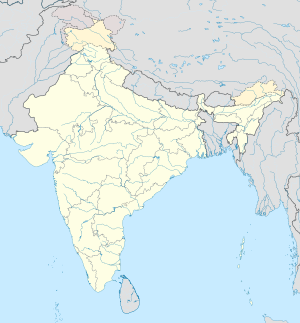Babri Masjid
| Babri Masjid | |
|---|---|
| بابری مسجد | |
| Basic information | |
| Location | Ayodhya, India |
| Geographic coordinates | title 26°47′44″N 82°11′40″E / 26.7956°N 82.1945°E |
| Architectural description | |
| Architectural style | Tughlaq |
| Completed | 1528–29 |
The Babri Masjid (translation: Mosque of Babur), was a mosque in Ayodhya, India. Located in Faizabad district, it was one of the largest mosques in the Uttar Pradesh state. According to the mosque's inscriptions, it was built in 1528–29 CE (935 AH) by Mir Baqi, on orders of the Mughal emperor Babur (after whom it is named).
The mosque was located on a hill known as Ramkot ("Rama's fort"). According to a section of Hindus, the Mughals destroyed a structure marking the birthplace of Rama (Ram Janmabhoomi) to build the mosque, a claim denied by the Muslims. The political, historical and socio-religious debate over the history of the site and whether a previous temple was demolished or modified to create the mosque, is known as the Ayodhya dispute.
Starting in the 19th century, there were several conflicts and court disputes between Hindus and Muslims over the mosque. On 6 December 1992, the demolition of the Babri Masjid by militant Hindu nationalist groups triggered riots all over India, leading to around 2,000 deaths.
The name "Babri Masjid" comes from the name of the Mughal emperor Babur, who is said to have ordered its construction. Before the 1940s, it was called Masjid-i-Janmasthan ("mosque of the birthplace"), including in the official documents such as revenue records.
The rulers of the Delhi Sultanate and their successors, the Mughals, were great patrons of art and architecture and constructed many fine tombs, mosques and madrasas. These have a distinctive style which bears influences of "later Tughlaq" architecture. Mosques all over India were built in different styles; the most elegant styles developed in areas where indigenous art traditions were strong and local artisans were highly skilled. Thus regional or provincial styles of mosques grew out of local temple or domestic styles, which were conditioned in their turn by climate, terrain, materials, hence the enormous difference between the mosques of Bengal, Kashmir and Gujarat. The Babri Mosque followed the architectural school of Jaunpur Sultanate. When viewed from the west side, it resembled the Atala Masjid in Jaunpur.
...
Wikipedia

